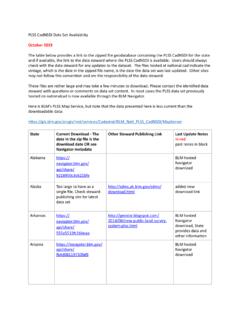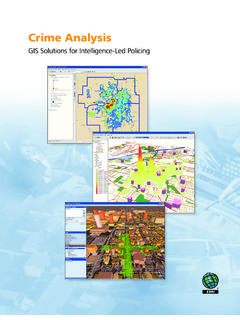Transcription of Standardized PLSS Data Set (PLSS CadNSDI) Users …
1 Standardized plss Data Set ( plss cadnsdi ) Users reference Materials October 2015 (reviewed October 2016) Handbook for plss Standardized Data If you have comments, suggestions, corrections or additions for the material in this document please send them to Comments will be accumulated, reviewed and incorporated into the next version of this material . Please see the information listed with the plss Work Group on the FGDC Cadastral Subcommittee publication site ( ) for additional information on the Standardized plss cadnsdi Data Sets. Handbook for Standardized plss cadnsdi Data ii Table of Contents Introduction.
2 1 Frequently Asked Questions .. 2 General Questions .. 2 Conflicted Areas - How should a GISer work around conflicted areas? .. 6 Survey System and Parcel Feature Classes - The feature classes "Survey System" and Parcel do not have any data in them, why is this? .. 6 plss Township .. 7 Metadata at a Glance .. 7 GIS Quick Start .. 8 Starting Layers .. 8 Other Layers .. 14 Acreages in plss cadnsdi .. 14 Key Concepts and Definitions .. 15 The Public Land Survey System ( plss ) concepts and terms .. 15 Manual of Instructions 2009 .. 15 Production, Publication and Project Data .. 16 Standards .. 16 Cadastral Data Content Standard .. 17 plss BLM Point ID Standard (2006).
3 17 Production Operation and Maintenance .. 18 BLM GCDB .. Error! Bookmark not defined. GCDB Users Guide .. Error! Bookmark not defined. Application of Concepts to the Standardized Data .. 19 Rectangular versus non-Rectangular .. 19 Nominal Locations .. 23 Segregated Surveys and Lotting .. 23 cadnsdi Description .. 25 Overview Versions Revision Vintage .. 25 Overview Data Structure .. 26 Feature Classes in Cadastral reference .. 29 Appendix A - Acronyms and Abbreviations .. 32 Appendix B - Standard Domains for plss cadnsdi .. 33 Appendix C - Feature Class Details .. 42 Handbook for Standardized plss cadnsdi Data iii List of Figures Figure 1 - plss Township Outlines with Labels.
4 8 Figure 2 - plss First Division Outline with Labels .. 9 Figure 3 - plss Township Outlines Symbolized by SRVTYP .. 10 Figure 4 - First Division Outlines Symbolized by FRSTDIVTYP .. 10 Figure 5 - plss Township with First and Second Division Outlines .. 11 Figure 6 - Zoomed in View of Figure 5 .. 11 Figure 7 - ArcMap Table of Contents .. 12 Figure 8 - Section Divided into Lots .. 13 Figure 9 - Meandered Water with plss Rectangular Features .. 13 Figure 10 - Apparent "Hole" is Rectangular plss .. 21 Figure 11 - Special Surveys in Apparent plss "hole" .. 21 Figure 12 - Meandered Water Body .. 22 Figure 13 - Lotting Around Figure 14 - Non-Segregation Lotting in a plss Township.
5 24 Figure 15 - MetadataGlance Symbolized by Data Steward .. 27 Figures in the appendix are included in this list Handbook for Standardized plss cadnsdi Data 1 Introduction This document provides supporting documentation for the Public Land Survey System ( plss ) Standardized data for the Cadastral National Spatial Data Infrastructure ( plss cadnsdi ) data set. The Frequently Asked Question (FAQ) section provides responses to questions most asked by those generally familiar with the plss and are starting to use this data set for the plss representation in a Geographic Information System (GIS). The Key Concepts and Definitions section provides links to source documents that provide additional detail and background on key terms and concepts related to the plss , cadastral data, related data standards and the specific procedures and processes used in the Bureau of Land Management (BLM) Cadastral Survey to develop coordinate positions on plss corners.
6 Application of Concepts to the Standardized Data section is an overview of some of the key concepts of the plss and their manifestation in the standard. This section provides a layman s description of some of the idiosyncrasies of the plss . The plss cadnsdi Description section describes the specific content of the plss cadnsdi data set. This is the data dictionary for the standard. Appendix A is a list of acronyms. Appendix B is a description of some of the more common anomalies in the plss data. Throughout this document the Feature Class names are in italics. Field names (attributes) are in CAPITOL letters. ArcMap is the Esri mapping software used by the BLM and is the software used in the implementation of this data set.
7 The Parcel Fabric is a data editing and maintenance tool that is a part of the Esri ArcMap solution. The Parcel Fabric is the tool set used by the BLM to maintain the plss cadnsdi . Updated data sets are published form the Parcel Fabric. Handbook for Standardized plss cadnsdi Data 2 Frequently Asked Questions These answers are intended to give the Users that are generally familiar with the data a quick start to using the data. General Questions What is NSDI? The NSDI1 is the National Spatial Data Infrastructure, which has been defined as the framework data sets that provide a basis to support decision-making and encourage the broad use of geographic information.
8 The goal of this Infrastructure is to reduce duplication of effort among agencies, improve quality and reduce costs related to geographic information, to make geographic data more accessible to the public, to increase the benefits of using available data, and to establish key partnerships with states, counties, cities, tribal nations, academia and the private sector to increase data availability. The Cadastral components of the NSDI, sometimes called the cadnsdi , are the core or essential elements of cadastral information that provide the framework for building and using cadastral (land records) information nationwide. The plss cadnsdi is the Public land Survey System ( plss ) cadastral reference components of the Cadastral data.
9 In addition to cadastral reference data there are parcel data and rights and interest data. This document and these guidelines in this document cover only the plss cadnsdi . What is Version 2 and Vintage? The Federal Geographic Data Committee (FGDC) Cadastral Subcommittee has published an updated version of the publication guidelines for the Standardized plss cadnsdi data sets. Version 2 represents updates to the formats, attribution, and definitions of features. Within the Standardized data sets, the data stewards will update the data content. This changing data set is termed a change in the Vintage, or the age or revision data but is not a change in the version.
10 The term version is meant to reflect the format and structure of the data and vintage is used to describe the age or revision of the data. The Version 2 format is a suggested minimum and data stewards may add fields to the core standard. This is expected and is in line with the expectation of the use of the standard. How was the data compiled? The original plss data content in the Standardized plss cadnsdi data set was developed by identified data stewards, who are recognized agencies that have the authority to develop and maintain cadastral information, using the best available information. This is typically survey data, control observations, and supplemental measurements.




